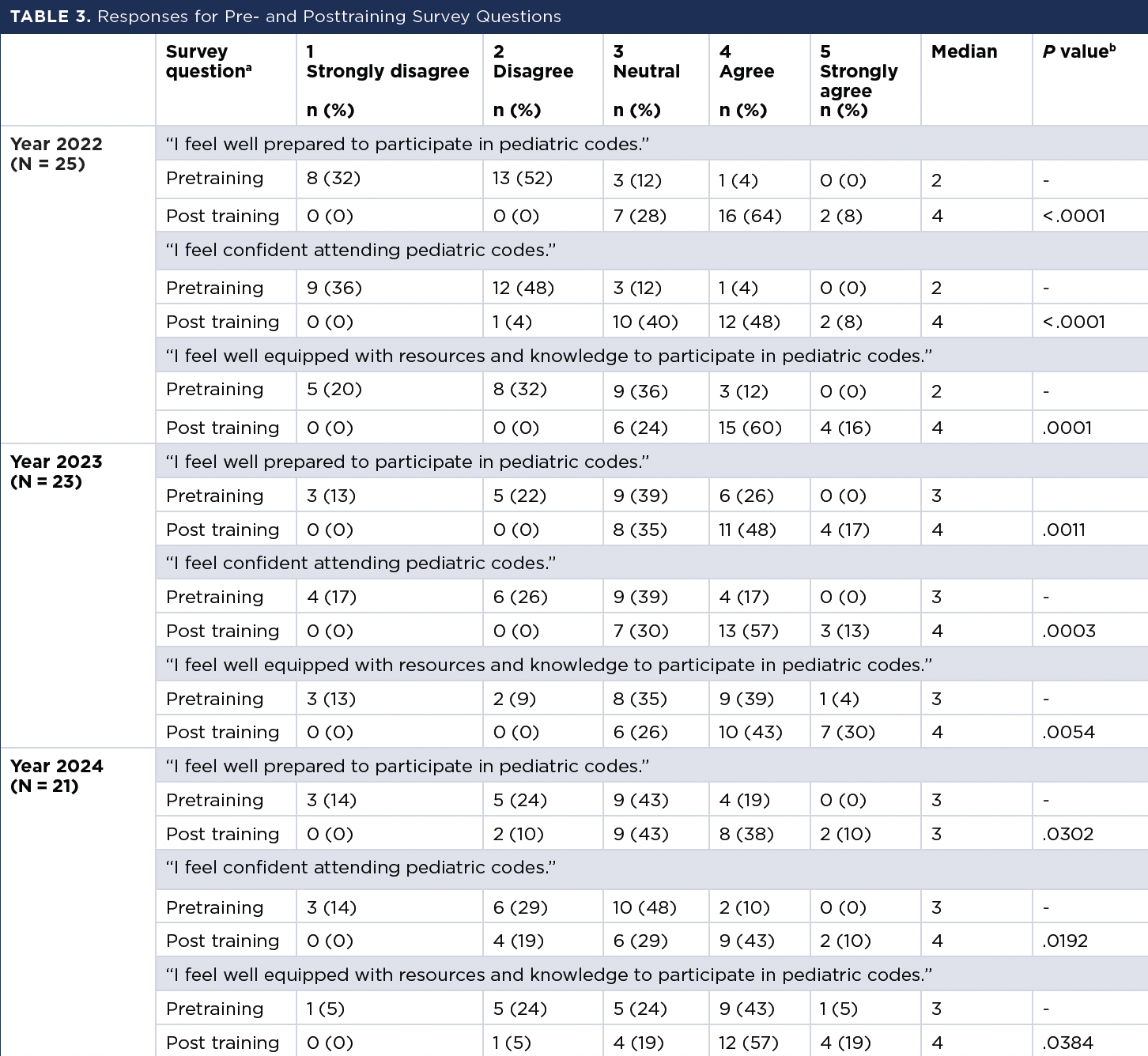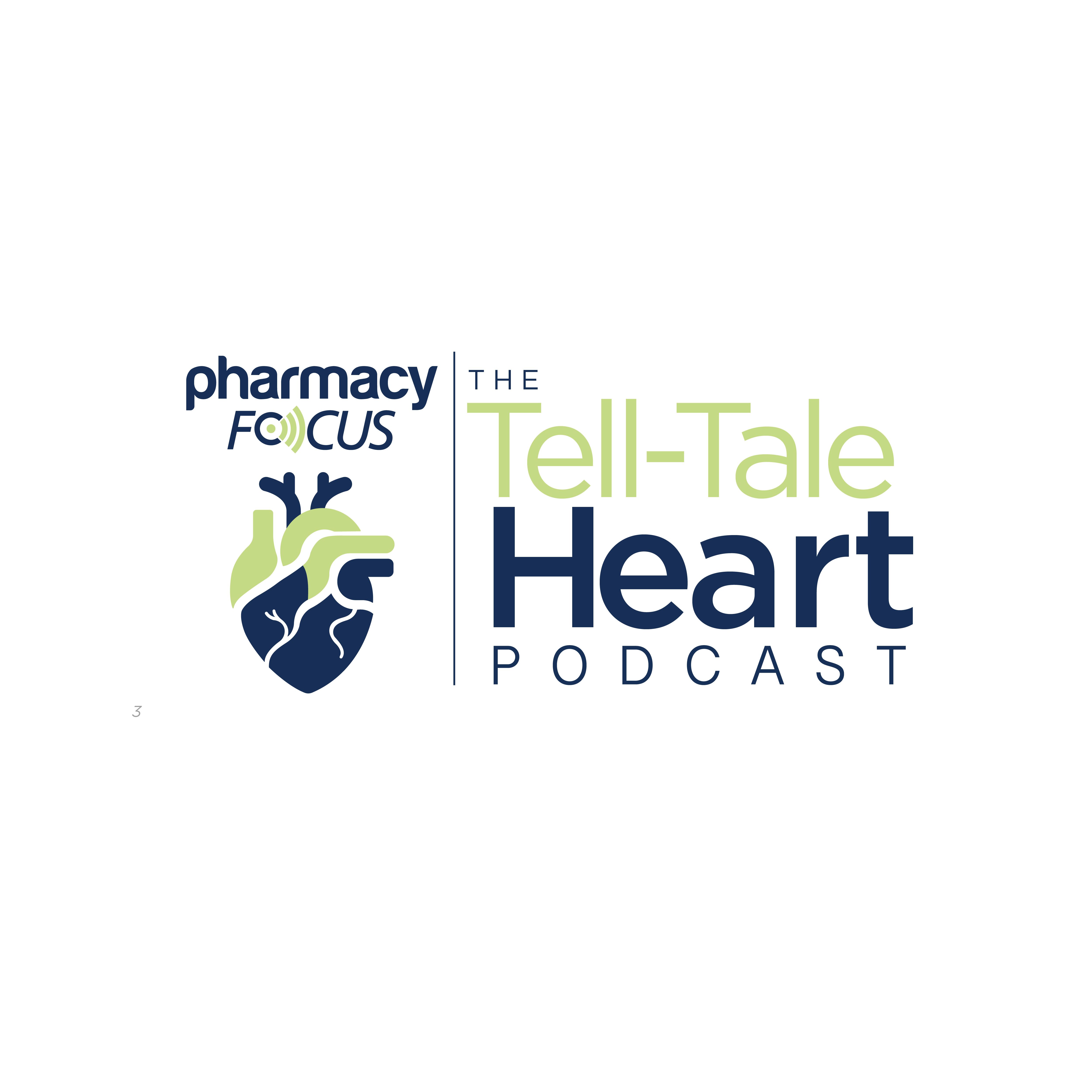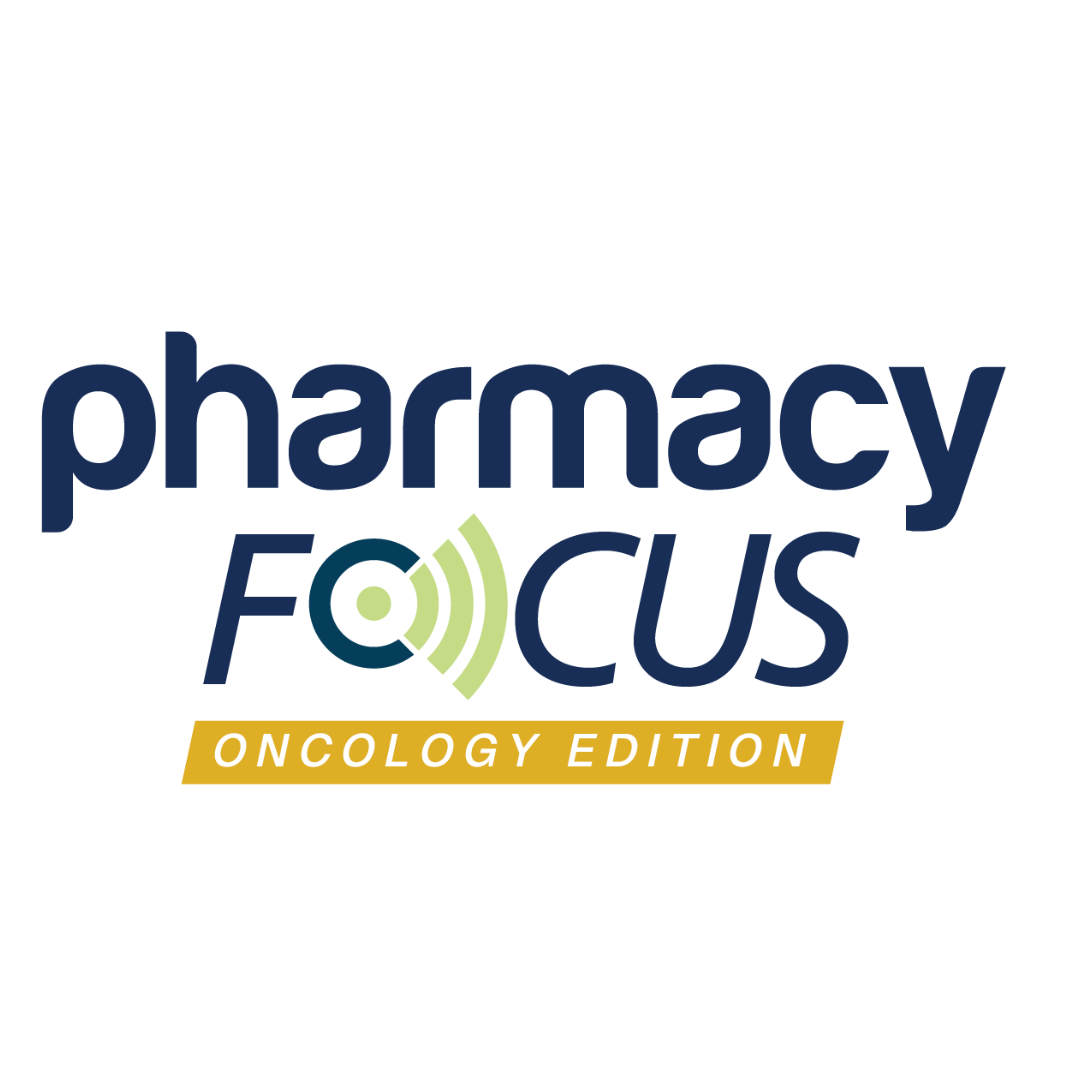Précis
Implementation of yearly mock code training can reinforce essential knowledge and increase pharmacists’ clinical competence and confidence when faced with actual neonatal and pediatric emergencies.
Abstract
Objectives
Current training resources for neonatal and pediatric emergencies are scarce, and limited materials are tailored to pharmacists, especially with a focus on medication dosing and preparation during codes. Hence, a community hospital initiated annual neonatal and pediatric mock code training to improve pharmacists’ clinical knowledge and comfort level when attending actual neonatal and pediatric code situations. The purpose of this study was to determine the impact of these trainings over time.
Study Design
This was a survey-based study of Sharp Chula Vista Medical Center’s 2022-2024 annual neonatal and pediatric mock code training for pharmacists. Participants completed pre- and post-training questionnaires containing 5-point Likert scale and clinical questions to measure changes resulting from the neonatal and pediatric mock code training.
Methods
Study questionnaires were anonymously completed by pharmacists in attendance before and after each training. The primary outcomes were changes in total clinical knowledge scores before and post training each year and over 3 years. Secondary outcomes were changes in preparedness and confidence as well as pharmacists’ satisfaction with resources and knowledge to participate in neonatal and pediatric emergencies.
Results
After the mock code training, increases in total clinical scores across all 3 years reached statistical significance (significance threshold: P < .05). Pharmacists’ preparedness, confidence, and satisfaction scores also significantly increased.
Conclusion
Annual neonatal and pediatric mock code training can reinforce essential knowledge and increase pharmacists’ clinical competence and comfort level during codes.
Introduction
Cardiopulmonary resuscitation—one of the most stressful situations in emergency medicine—is associated with increased risks of medication errors resulting in patient harm because medical decisions are made frequently with limited information and time for discussion.1 Medication errors during codes are 39 times more likely to cause harm and 51 times more likely to result in patient death than non–code-related errors.2
The most common errors are drug selection errors and dosing errors.2 According to the Institute for Safe Medication Practices, a study of mock pediatric resuscitations found that 20% of verbal orders did not specify a dose and 50% did not include a route of administration.1 As drug information experts, pharmacists can help prevent these errors.
Pharmacists are essential members of the interdisciplinary team, serving as drug information experts to ensure correct dosage and timeliness of medications to patients. During codes, pharmacists can provide drug recommendations, calculate dosages, prepare medications, and time administration of medications.3 Pharmacists’ participation in codes has been found to reduce mortality by reducing adverse drug reactions and medication errors.4,5 Having a pharmacist present during codes also has been linked to increased compliance with advanced cardiac life support guidelines.6
Inpatient pharmacists are often called upon during neonatal and pediatric emergency codes because having a pharmacist in attendance has been shown to provide comfort and relief to the interdisciplinary team.7 The Pediatric Pharmacy Advocacy Group recommends that pharmacists participate at neonatal and pediatric emergency codes and that all institutions adopt training competency programs to ensure pharmacists are educated on pharmacotherapy of drugs used during emergency code events.7 However, literature and training resources for neonatal and pediatric emergencies are scarce, and limited materials are tailored to pharmacists. From our experience, Pediatric Advanced Life Support (PALS) training offered through the American Heart Association’s Resuscitation Quality Improvement Program focuses on high-quality cardiopulmonary resuscitation but lacks focus on medication dosing and preparation. Therefore, pharmacists may feel unprepared and unconfident when attending emergency codes.3,7
Previous pediatric mock code trainings tailored toward medical residents and nurses have resulted in significant improvement in knowledge, confidence, and comfort levels.8-11 Some of these trainings included pharmacy as part of the medical team, and some did not. To our knowledge, no studies have been done to evaluate the impact of mock code training on pharmacists’ competencies and comfort levels. The purpose of this study was to evaluate the impact of annual neonatal and pediatric mock code training at a community hospital on pharmacists’ clinical knowledge, preparedness, and confidence, as well as their satisfaction with resources and knowledge to participate in neonatal and pediatric emergencies.
Materials and Methods
Annual neonatal and pediatric mock code educational training was initiated at the beginning of 2022 at Sharp Chula Vista Medical Center (SCVMC), a community hospital within a health system in San Diego County, California. This study examines the years 2022-2024 of the annual training. Participants included inpatient pharmacists employed at SCVMC. The intent of the training was to improve participants’ knowledge and comfort level during neonatal and pediatric codes. Participants anonymously completed a pre-training questionnaire and then participated in an educational training session.
The educational training consisted of mock scenario cases for both neonatal and pediatric codes requiring hands-on adaptation and manipulation of real medications, medical devices, and resources. Separate code trays for the neonatal and pediatric populations were available during training. Each mock session lasted 1 hour and consisted of 4 to 6 pharmacists to ensure productive, interactive participation.
Promptly after completion of the training session, participants anonymously completed a post-training questionnaire without access to the training materials. The questionnaires contained survey and clinical questions to measure changes resulting from the training. Survey questions were answered using a 5-point Likert scale: (1) strongly disagree, (2) disagree, (3) neutral, (4) agree, or (5) strongly agree. Clinical questions were answered by filling in the blanks and worth 1 point each.
Study Sample
To be included in the study, inpatient pharmacists had to have been employed at SCVMC, have attended the annual mock code training, and have completed both the pre- and post-training questionnaires. The primary outcomes were changes in total clinical knowledge scores on pre- and post-training questionnaires each year and over time. Secondary outcomes were changes in preparedness, confidence, and satisfaction scores on pre- and post-training questionnaires each year and over time. This was a survey-based study and was deemed exempt from institutional review board review and approval.
Statistical Analysis
Paired t test was used to analyze the primary outcome of changes in inpatient pharmacists’ total clinical knowledge scores pre- and post-training each year. Wilcoxon signed-rank test was used for the secondary outcome of changes in inpatient pharmacists’ preparedness, confidence, and satisfaction scores pre- and post training each year. Descriptive analysis was used to report changes in inpatient pharmacists’ total clinical knowledge, preparedness, confidence, and satisfaction scores over time (a 3-year span). A P value less than .05 was considered statistically significant.
Results
A total of 25, 23, and 21 pharmacists completed the annual neonatal and pediatric mock code training in 2022, 2023, and 2024, respectively (Table 1). For 2023 and 2024, the group included repeat and new pharmacists. For all 3 years, the majority of pharmacists were women and aged 40 to 49 years. Most had postgraduate year 1 training and had been registered pharmacists in California for more than 10 years. Approximately 25% of pharmacists were PALS certified.
Primary Outcomes
After each annual neonatal and pediatric mock code training, total clinical scores increased significantly (Table 2). In 2022, pharmacists’ scores for each clinical question (except for question 3) and overall scores significantly increased from pre- to post-training (total mean score: 3.53 vs 6.49, respectively; P < .0001). In 2023, pharmacists’ scores for each clinical question (apart from question 4) and overall scores also significantly increased (total mean score: 2.86 vs 4.51; P < .0001). Again in 2024, the increases in pharmacists’ scores for each clinical question and overall scores reached statistical significance (total mean score: 2.53 vs 4.67; P < .0001). Scaled total scores on pre- and post-training questionnaires were consistent across all 3 years; the pre-training scaled total scores of 50.43%, 57.25%, and 50.61% increased to 92.71%, 90.22%, and 93.60% post training for 2022, 2023, and 2024, respectively.
Secondary Outcomes
After each year’s training, pharmacists’ preparedness, confidence, and satisfaction scores increased (Table 3). Agreement/disagreement with 3 survey statements “I feel well prepared to participate in pediatric codes,” “I feel confident attending pediatric codes,” and “I feel well equipped with resources and knowledge to participate in pediatric codes” were used to score preparedness, confidence, and satisfaction, respectively. After training in 2022, more pharmacists agreed with all 3 statements (pre-training median score: 2 [disagree] vs post-training median score: 4 [agree]; P < .0001). In 2023 and 2024, pharmacists’ responses post training remained statistically significant. Except for the post-training preparedness statement in 2024, most responded feeling neutral pre-training but agreed or strongly agreed post training to feeling prepared, confident, and satisfied (median score: 3 [neutral] vs 4 [agree]; P < .05).
Discussion
The results of this study showed that the implementation of annual neonatal and pediatric mock code training positively impacted pharmacists at a community hospital by leading to increased knowledge and comfort levels for participation in codes.
On the post-training questionnaires each year, clinical scores showed a statistically significant increase. However, studies have shown that the skills and knowledge gained from advanced life support courses significantly deteriorate over time.10 Thus, most required trainings and competencies across hospital institutions, such as basic life support and advanced cardiac life support, are mandated annually for health care practitioners, including pharmacists, to reinforce their knowledge and skills.
The annual neonatal and pediatric mock code training emphasized key learning objectives involving dosing and preparation of medications for neonatal and pediatric emergencies and common situations that could occur during codes. Because both repeat and new pharmacists attended in 2023 and 2024, the materials presented throughout the 3 years were distinctively designed to deliver new education in a productive and interactive format. Although the clinical questions were different, limiting comparison of the results between years, the training materials emphasized similar key points and concepts to promote retention of information. For example, recurring topics included neonatal and pediatric advanced life support, Broselow tape, emergency intravenous medications and drips, and infusion drug pump libraries. Each year’s training served as a building block for the subsequent year, with pharmacists’ level of learning advancing from comprehension to application. Mariani et al evaluated the effect of repeat exposures to pediatric mock code simulations and found significant differences in participants’ knowledge of pediatric emergencies and no significant decline in performance over time, which may indicate that repeat exposure to mock code simulations can contribute to retention of competency.11
Although pharmacists’ preparedness, confidence, and feeling of being well equipped to attend neonatal and pediatric codes significantly increased across all the years, the increase was less significant in 2024. This could be partly attributed to the smaller sample size (due to staffing changes that occurred). In addition, the training in 2024 occurred during the hospital’s transition to a different electronic health record system, which was a time of high stress and could have contributed to more neutral feelings toward preparedness. Baseline preparedness, confidence, and satisfaction scores from pre-training questionnaires did increase from 2022 to 2023 but plateaued from 2023 to 2024, which may suggest some lasting psychological benefits.
For SCVMC, conducting annual neonatal and pediatric mock code training proved valuable in reinforcing essential knowledge and improving comfort levels for pharmacists who participate in neonatal and pediatric codes. Mock code training was made feasible by first getting leadership buy-in, followed by creating an action plan with training champions, and then developing training materials. Positive findings from the pre- and post-training questionnaires from the first year prompted leadership to adopt annual training for 2023 and 2024.
Future studies involving mock code training across different and larger health systems could provide an accessible and standardized educational intervention for inpatient pharmacists. Opportunities to further measure training effectiveness could utilize a stimulation assessment and conduct a comparator study with a control group or a cohort study with repeated post-training questionnaires after 3 or 6 months.
Conclusions
About the Authors
Lucy Phan Vo, PharmD, BCPS, BCEMP, is the emergency medicine clinical pharmacist and residency program coordinator at Sharp Chula Vista Medical Center in Chula Vista, California.
Vy Vivian Vo, PharmD, is a PGY-1 resident pharmacist at Sharp Chula Vista Medical Center in Chula Vista, California.
Pamela Dobbs, PharmD, BCPS, is the lead clinical pharmacist at Sharp Chula Vista Medical Center in Chula Vista, California.
The implementation of annual neonatal and pediatric mock code training significantly increased pharmacists’ knowledge and comfort level in attending neonatal and pediatric codes. However, because these skills can decline over time, it is necessary to conduct these trainings regularly. Formal, periodic mock code simulations can reinforce and enhance pharmacists’ anticipation skills, confidence, and clinical competence to increase their medical preparedness during actual neonatal and pediatric emergencies.
Acknowledgments
The authors would like to express their sincerest gratitude and appreciation to the following individuals for their contribution to and support in the completion of this project: Kim Schwab, PharmD, BCPS; Grant Lum, PharmD; the SCVMC postgraduate year 1 resident pharmacists from the class of 2022, class of 2023, and class of 2024; and the rest of the staff at SCVMC.
REFERENCES
1. Institute for Safe Medication Practices. Preventing medication errors during codes. ISMP Medication Safety Alert! Acute Care Edition. Accessed July 25, 2024. https://www.ismp.org/resources/preventing-medication-errors-during-codes
2. Lipshutz AK, Morloc LL, Shore AD, et al. Medication errors associated with code situation in U.S. hospitals: direct and collateral damage. Jt Comm J Qual Patient Saf. 2008;34(1):46-56. doi:10.1016/s1553-7250(08)34007-0
3. Jackevicius C. Pharmacist participation in CPR needs resuscitation. Can J Hosp Pharm. 2015;68(4):275-276. doi:10.4212/cjhp.v68i4.1465
4. Bond CA, Raehl CL. Clinical pharmacy services, pharmacy staffing, and adverse drug reactions in United States hospitals. Pharmacotherapy. 2006;26(6):735-747. doi:10.1592/phco.26.6.735
5. Bond CA, Raehl CL. Clinical pharmacy services, pharmacy staffing, and hospital mortality rates. Pharmacotherapy. 2007;27(4):481-493. doi:10.1592/phco.27.4.481
6. Draper HM, Eppert JA. Association of pharmacist presence on compliance with advanced cardiac life support guidelines during in-hospital cardiac arrest. Ann Pharmacother. 2008;42(4):469-474. doi:10.1345/aph.1K475
7. Johnson PN, Mitchell-Van Steele A, Nguyen AL, Stoffella S, Whitmore JM; Advocacy Committee for the Pediatric Pharmacy Advocacy Group. Pediatric pharmacists’ participation in cardiopulmonary resuscitation events. J Pediatr Pharmacol Ther. 2018;23(6):502-506. doi:10.5863/1551-6776-23.6.502
8. Mikrogianakis A, Osmond MH, Nuth JE, Shephard A, Gaboury I, Jabbour M. Evaluation of a multidisciplinary pediatric mock trauma code educational initiative: a pilot study. J Trauma. 2008;64(3):761-767. doi:10.1097/TA.0b013e3180341ff8
9. Tofil NM, Lee White M, Manzella B, McGill D, Zinkan L. Initiation of a pediatric mock code program at a children’s hospital. Med Teach. 2009;31(6):e241-e247. doi:10.1080/01421590802637974
10. Rimon A, Hess A, Scolnik D, Tavor O, Friedman S, Glatstein M. Evaluation of a pediatric mock code educational training program at a large, tertiary care pediatric hospital. Open J Pediatr. 2015;5(4):314-319. doi:10.4236/ojped.2015.54047
11. Mariani B, Zazyczny KA, Decina P, et al. Simulation for clinical preparedness in pediatric emergencies: a pilot study. J Nurses Prof Dev. 2019;35(1):6-11. doi:10.1097/NND.0000000000000500
The authors have no disclosures.












